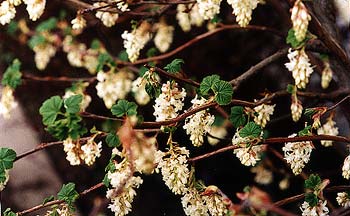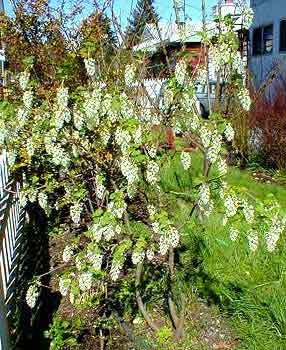 The elegant 'White Icicle' Flowering Currant
The elegant 'White Icicle' Flowering Currant
"Under the brown fog of a winter noon
Mr. Eugenides, the Smyrna merchant
Unshaven, with a pocket full of currants."
-T.S. Eliot
(1888-1965)
(1888-1965)
While doing the dishes we can look out the kitchen window & see the 'White Icicle' flowering currant, together with a stand of evergreen huckleberries & a fruiting cherry tree.
Or, when we enter the yard by the basement side-door, we pass through the arbor that parts the way between a big Lady Banks' Rose & a huge Forsythia. The Forsythia is in bright yellow bloom the same time as the 'White Icile' shows its white flowers. The yellow & the white provide quite a contrast.
The white currant stands about five & a half feet tall, having very pretty three-trunk form even in the dead of winter, when the bark turns purplish (see the 'White Icicle' Currant Page along the Winter Bark Garden Walk). The shrub will someday be eight feet tall; ten feet is not impossible.
 The scientific name Ribes sanguineum means "bitter-tasting bloody one," though for flavor it's more bland than bitter, & the 'White Icicle's' blooms aren't blood-colored like the wild original.
The scientific name Ribes sanguineum means "bitter-tasting bloody one," though for flavor it's more bland than bitter, & the 'White Icicle's' blooms aren't blood-colored like the wild original.This white-flowering form of the native northwest currant was first developed in Victoria on Vancouver Island. It is very likely the most beautiful of all the currant cultivars, its dangly blooms being larger than on the species, & very appealing to hummingbirds. Apart from the possibility of aphids liking it, it is extremely hardy & disease resistant & easily grown from cuttings or seeds.
It is wonderful enough that it is sometimes planted as a sole specimen shrub dead center in a lawn, as though the whole landscape were designed for its display, but it is also so easily grown it is sometimes relegated to groupings at the back edges of a property. Being native of around here, it likes our temperate weather about best of anything, but it is also extremely cold hardy & is an ideal shrub for more northerly climates too.
In March & April it is gloriously abloom, as seen in this page's April 2002 blossom portrait up top, & by the second portrait taken March 2003. White Icicle is sometimes regarded a "winter bloomer" because it blooms earliest of almost any Ribes cultivar, two weeks ahead of most red ones & even the red is already a last-week-of-winter bloomer. But in our garden 'White Icicle' is at its height the first two weeks of spring. Some people say the flowers smell bad; I find the odor grassy or weedy, which while not perfumy is also not unpleasant.
The blooms emerge when the leaves are mere whispers of their future selves, but last long enough that there are soon young leaves peaking all around the blooms. The flowers give way later in spring to blue-black currants that last clear to the end of summer. To see the berries, check the 'White Icicle' Currant page in the Drupes & Berries Gallery.
The berries are bland but edible right off the bush, & Northwest Native Americans harvested them seasonally. The species is not tasty enough to be a significant commercial crop, Ribes nigrum being the preferred black currant & R. rubrum the preferred red berry for jams & jellies. But there's no reason R. sanguineum couldn't do a quick stand-in during home canning, especialy if mixed with other fruits to make a currant-orange marmelaide or a jam of currant & black cherry. But leaving them in the garden on the bush is no waste; they're decorative & of course birds love them.
Autumn colors are not guaranteed to be extremely showy, but the leaves do generally turn an attractive golden yellow, vital enough that there is a separate page for the 'White Icicle' Currant in the Autumn Leaves Gallery.
White folks first laid eyes on the natural red form of the flowering shrub in 1793 when it was described by Archibald Menzies on the voyage of Captain George Vancouver. In 1817 it was brought to Great Britain by Scotsman David Douglas who within ten years had established it as a wealthy gardeners' favorite.
The first cultivated form was named 'King Edward VII,' & this was much later re-introduced to North American Gardeners, remaining popular right up to the present day. We also have one of the most recent cultivars, R. sanguineum 'Brocklebankii' Golden Currant with yellow leaves.